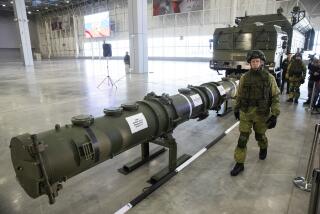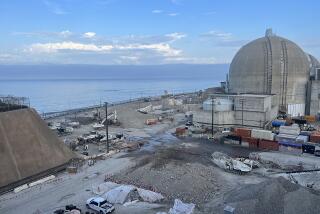Some Could Become Museum Pieces : Pact Specifies When, How to Destroy Arms
WASHINGTON — Pershing 2 nuclear missiles may soon join Civil War-era cannons on American courthouse lawns or, more likely, be put on display at aeronautical museums around the country as a result of the intermediate nuclear forces treaty signed Tuesday by President Reagan and Soviet leader Mikhail S. Gorbachev.
The treaty provides that each country can destroy up to 15 of its missiles by removing the warheads and guidance systems and putting them on “static display”--the technical term for what happens when over-the-hill weapons are turned into museum pieces.
For the first time in the nuclear era, the United States and the Soviet Union have agreed to destroy weapons, not just limit the growth of arsenals.
The result is an incredibly detailed and complex pact--covering 56 pages of treaty and protocols backed up by a “memorandum of understanding” of about 140 pages--spelling out in exquisite detail the procedure for destroying the weapons and outlining the ways that each country can check to make sure that the other does not cheat.
Within three years after the treaty is ratified, the Soviet Union will be required to destroy 1,752 missile systems, and the United States will be required to destroy 859 missile systems. About half of the missile systems are actually deployed in Europe and Soviet Asia; the rest, though in storage, must also be destroyed.
Novel Means of Disposal
Most of the weapons will be blown up, cut into scrap, crushed or burned. But the treaty also allows novel means of disposal, including the static displays in museums.
Each side will be permitted to destroy up to 100 missiles by launching them once their war-heads have been removed. Weapons handled that way must be fired one at a time, with no more than six hours between shots. They may not be used as targets for testing anti-ballistic missile systems. The Soviets have indicated that they will take advantage of this provision, but U.S. officials say the United States probably will not.
Most of the weapons face a much more prosaic end. For instance, the main sections of the U.S. Pershing 2 and Soviet SS-20 missiles must be eliminated “by explosive demolition or burning.” Solid fuel, rocket nozzles and motor cases must be “burned, crushed, flattened or destroyed by explosion.” And the missile nose cones, with the nuclear device and the guidance system removed, must be “crushed or flattened.”
U.S. ground-launched cruise missiles must be “cut longitudinally into two pieces,” the wings and tail sections must be cut off “at locations that are not assembly joints” and the nose cone, minus the warhead and guidance system, must be “crushed or flattened.”
So far, only the 19-page treaty, a 16-page protocol covering methods of destruction and a 21-page protocol covering on-site inspections and other verification measures have been made public.
Concern About Terrorists
A State Department official said the 140-page memorandum of understanding was not released because it contains precise information about the location of the weapons that could be used by terrorists. However, Alexei A. Obukhov, the deputy chief of the Soviet arms control delegation, said Moscow will soon publish the memorandum.
The treaty requires destruction of intermediate-range and shorter-range nuclear missiles, both deployed and in storage. At the present time, according to the treaty, the United States has deployed 429 intermediate-range missiles, with ranges of 600 to 3,000 miles, and has stored 260. The Soviet Union has 470 intermediate-range missiles deployed and 356 in storage.
For shorter-range systems, with ranges of between 300 and 600 miles, the United States has none deployed and 170 in storage. The Soviets have 387 deployed and 539 in storage.
The total numbers of deployed missiles differ from the commonly understood figures--those published by the Arms Control Assn.--for a variety of reasons. For example, both sides keep spares in the event some of their launcher-mounted missiles need to be sent to the shop for maintenance; the spares count as deployed missiles. The Soviets’ shorter-range missile launchers can be reloaded after they are fired; the Arms Control Assn. counts these as single missiles, but the treaty counts them as multiples.
Within 90 days of the effective date of the treaty, the Soviets will be required to remove all of their deployed shorter-range systems from their bases and send them to destruction depots. Both sides will then have 18 months to destroy the weapons.
All intermediate-range missiles must be destroyed within three years, but the schedule is complex because Moscow begins the process with a substantial lead. During the first 29 months, each side must reduce its deployed arsenals to weapons carrying no more than 180 warheads. Each side may have missiles carrying another 20 warheads in storage.
All the U.S. weapons in the class are single-warhead systems, but most of the Soviet weapons are SS-20 missiles with three warheads apiece. That means that after 29 months, Washington can maintain 180 deployed missiles with 20 more in storage, but the Soviets can have only 60 SS-20s deployed with six more in storage.
Final Seven Months
During the first phase, the United States must destroy 489 missiles and the Soviets must eliminate 760 missiles. For the final seven months, the United States would destroy three missiles for every one triple-warhead missile destroyed by the Soviet Union.
The treaty calls for the most detailed procedures to prevent cheating of any post-World War II agreement and perhaps the most intrusive verification procedures of any treaty in history.
Each side will be authorized to inspect every intermediate- or shorter-range missile facility maintained by the other side. That includes about 30 sites in the United States and five European allied countries--Britain, West Germany, Belgium, Italy and the Netherlands--and about 100 sites in the Soviet Union, Czechoslovakia and East Germany.
More to Read
Sign up for Essential California
The most important California stories and recommendations in your inbox every morning.
You may occasionally receive promotional content from the Los Angeles Times.










